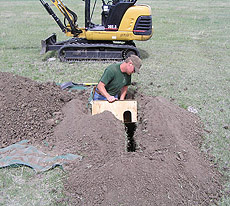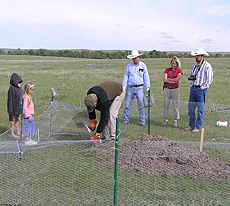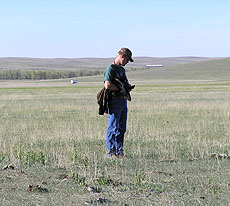Prairie Dog Relocation to Eastern Colorado
Roe Ecological Services relocated black-tailed prairie dogs back onto a ranch in Eastern Colorado from which prairie dogs had be extirpated decades prior under a grant from the U.S. Fish and Wildlife Service, and with the cooperation of Colorado Parks and Wildlife (formerly the Colorado Division of Wildlife).
Prior to the summer of 2005, not only were prairie dogs not found on the Lasater Ranch, but, based on a Colorado Division of Wildlife aerial survey of black-tailed prairie dog (Cynomys ludovicianus) populations in the area, no active prairie dog colony was reported within 25 miles of the property (CDOW 2003). Reestablishment of the black-tailed prairie dog at the Lasater Ranch would mean not only wider distribution of the animals in southern Elbert County, but, due to the prairie dog’s well known role as a “keystone species,” might also be expected to lead to increased distribution of nesting Burrowing Owl and Mountain Plover and overwintering of Ferruginous Hawks on the property.
Prairie dogs can have a significant effect—either negative or positive— on community structure or ecosystem function. That is to say, they can in some instances degrade an ecosystem, and in others be responsible for making it more complete, even to the point of supporting it. For this reason prairie dogs have been labeled a “keystone species.” Depending on ecosystem and habitat type, the positive effect—provision of habitat and prey resources for other wildlife species—may be greater than otherwise expected based on abundance. Further, research indicates that nine vertebrate species may be dependent upon prairie dogs at least to some degree.
Testing of the keystone species theory would involve introduction of black-tailed prairie dogs to an area from which they had been absent for many years, and observing the expected change in community structure—a sort of “If you build it, will they come?” effort. Prior to 2005, however, very little such testing had been conducted. Establishment of a black-tailed prairie dog colony at the Lasater Ranch, it was thought, would permit the investigation (over a five-year period beginning in 2005) of the keystone-species theory in an eastern Colorado shortgrass prairie setting, making possible the evaluation of whether or not Ferruginous Hawks, Western Burrowing Owls, and Mountain Plovers would begin utilizing previously unoccupied habitat, or would use it with greater frequency, once prairie dogs had been established on site.
Read one of the monitoring reports HERE.
For more information on Roe Ecological Services’ prairie dog relocations go HERE.




